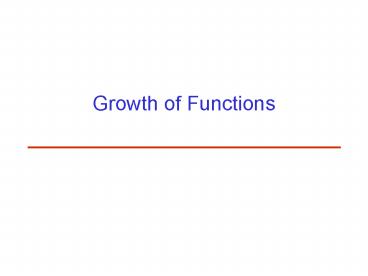Growth of Functions - PowerPoint PPT Presentation
1 / 12
Title:
Growth of Functions
Description:
How the running time of an algorithm increase with the size of the input in the ... transpose symmetry, and trichotomy of asymptotically positive functions ... – PowerPoint PPT presentation
Number of Views:98
Avg rating:3.0/5.0
Title: Growth of Functions
1
Growth of Functions
2
Introduction
- Order of growth of the running time of an
algorithm - Characterization of the algorithms efficiency
- Is used to compare relative performance of
alternative algorithms - Asymptotic efficiency of algorithms
- How the running time of an algorithm increase
with the size of the input in the limit, as the
size of the input increases without bound - Usually, an algorithm that is asymptotically more
efficient will be the best choice for all but
very small inputs.
3
Asymptotic Notation
4
?-notation
- ?(g(n)) f(n) there exist positive constants
c1, c2 and n0 such that 0 ? c1g(n) ? f(n) ?
c2g(n) for all n ? n0 - Domains of functions are the set of natural
number - f(n) and g(n) must be asymptotically nonnegative
- ?(g(n)) is a set of functions
- f(n) is a member of ?(g(n)) ? f(n) ? ?(g(n)) ?
f(n) ?(g(n)) - f(n) is equal to g(n) within a constant factor
- g(n) is an asymptotically tight bound for f(n)
- The lower-order terms of an asymptotically
positive function can be ignored in determining
asymptotically tight bounds because they are
insignificant for large n
5
?-notation (Cont.)
6
?-notation (Cont.)
- Prove that
- Determine c1, c2 and n0 such that
- c11/14, c21/2, n07
- Prove that
- Suppose for the purpose of contraction that c2
and n0 exist such that
Impossible for arbitrarily large n, since c2 is
constant.
7
O-notation
- O(g(n)) f(n) there exist positive constants c
and n0 such that 0 ? f(n) ? cg(n) for all n ? n0 - Asymptotic upper bound
- f(n) ?(g(n)) implies f(n) O(g(n)) ? ?(g(n))
? O(g(n)) - an2 bn c O(n2)
- an b O(n2) (Why???)
- O-notation is often used to describe the
worst-case running time of an algorithm - The running time of an algorithm is O(g(n)) ?
there is a function f(n) that is O(g(n)) such
that for any value of n, no matter what
particular input of size n is chosen, the running
time on that input is bounded from above by the
value f(n)
8
O-notation (Cont.)
9
?-notation
an2 bn c ?(n2)an2 bn c ?(n)
- ?(g(n)) f(n) there exist positive constants c
and n0 such that 0 ? cg(n) ? f(n) for all n ? n0 - Asymptotic lower bound
- f(n) ?(g(n)) implies f(n) ?(g(n)) ? ?(g(n))
? ?(g(n)) - ?-notation is often used to describe the
best-case running time of an algorithm - The running time of an algorithm is ?(g(n)) ?
there is a function f(n) that is ?(g(n)) such
that for any value of n, no matter what
particular input of size n is chosen, the running
time on that input is bounded from below by the
value f(n) - Theorem 3.1. For any two functions f(n) and g(n),
we have f(n) ?(g(n)) if and only if f(n)
O(g(n)) and f(n) ?(g(n))
10
?-Notation (Cont.)
11
o-notation and ?-notation
- o(g(n)) f(n) for any positive constant c,
there exists a positive constant n0 such that 0 ?
f(n) lt cg(n) for all n ? n0 - Denotes an upper bound that is not asymptotically
tight - 2n2 O(n2) ? asymptotically tight
- 2n O(n2) ? not asymptotically tight
- 2n o(n2) but 2n2 ? o(n2)
- ?(g(n)) f(n) for any positive constant c,
there exists a positive constant n0 such that 0 ?
cg(n) lt f(n) for all n ? n0 - Denotes an lower bound that is not asymptotically
tight - n2/2 ?(n) but n2/2 ? ?(n2)
12
Self-Study
- Section 3.1. Asymptotic notation in equations and
inequalities (pp. 46-47) - Section 3.1. Comparison of functions (pp. 49-50)
- Transitivity, reflexivity, symmetry, transpose
symmetry, and trichotomy of asymptotically
positive functions - Section 3.2. Standard notations and common
functions (pp. 51-56)































